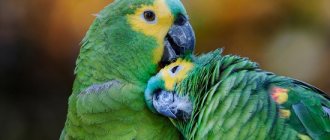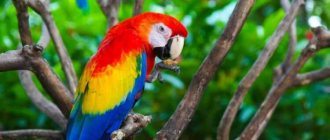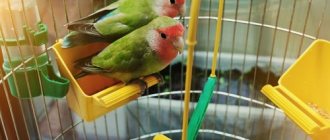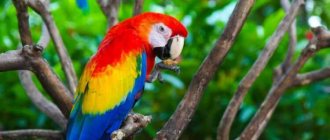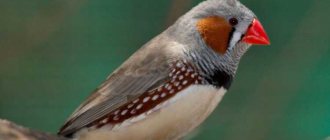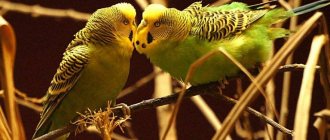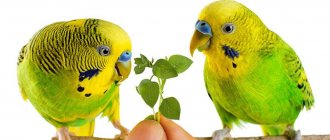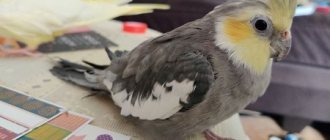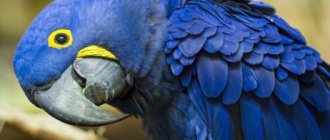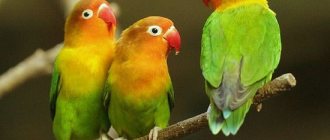- home
- Parrot
- General information
04/12/2019 Small budgies have always attracted the attention of both adults and small children. These funny feathered creatures have only recently gained popularity among breeders, but have already gained love and popularity. Not many people know a variety of interesting facts about budgerigars; the most interesting of them are collected in this article.
Budgerigar: description
The budgerigar has a stepped tail, the length of which is about 10 centimeters. Thanks to the long tail, the size of the parrot itself visually increases, although the length of the body does not exceed 23 cm. The weight of an adult is no more than 50 grams.
On the back of the head, towards the back of the head and further along the back, on a yellow background you can see dark lines in the form of waves, the thickness of which increases towards the back. In young individuals this pattern is somewhat blurred.
Modern artificially bred parrots are distinguished by a huge variety of colors, while the characteristic waves may be absent.
The bird's beak is curved and strong; at its base there is a wax with nostrils and covered with a horny layer. The same thin coating is found on the tip of the parrot's tongue.
The color tone of the cere indicates the gender of the bird: an adult male has a bright blue cere, a young parrot has a purple cere, an adult female has it brown or blue, and a young parrot has a blue one.
The beak of a parrot functions differently from that of other birds, but is more mobile. The thing is that its longer upper part is connected to the skull using a tendon. In chicks the beak is dark or pale yellow, with a greenish tint in adults.
With the help of its unique beak, the bird is able to perform a number of quite important functions. For example:
- With the help of its beak, a parrot can hold and move various objects.
- With the help of its beak, the bird crushes small twigs, plant fruits, seeds and leaves.
- The beak helps the parrot climb trees and other surfaces.
- Often the beak becomes a weapon for defense.
The parrot easily picks the fruits, peels off the husks and crushes them thanks to the presence of horny teeth, which are located inside the beak. With the help of these teeth the front part of the beak is also sharpened.
Interesting fact! The feathers of males, which are located on the forehead, emit a glow in ultraviolet rays. The brighter this glow, the more attractive the male is to the female.
On each parrot's foot (and there are two of them) there are 4 fingers of a grayish-blue or pink hue. In this case, two fingers look forward and two back. This arrangement of fingers allows the bird to feel great both on tree branches and on a horizontal surface. In addition, the parrot turns on the functions of its paws when it feeds, since it can hold any objects with its paws at a level with its beak.
Habitat, habitat in the wild
Australia is considered the birthplace of budgerigars, so it is in this country that the natural habitats of these amazing birds are located.
The habitat of these birds extends to the southwestern and eastern coasts, as well as to nearby islands, including the island. Tasmania. At the same time, the bird avoids areas with dense forests located somewhat to the north.
Birds prefer to nest in steppe and semi-desert zones characterized by open forests.
In the northern part of the continent, budgerigars breed their offspring, regardless of the time of year, and in the southern part, this period occurs in November-December.
Parrots lead a gregarious lifestyle, with each flock containing several dozen or several hundred individuals. As part of a flock, they migrate from place to place in search of food and water. Flocks of budgerigars can often be seen occupying green plains, where they eat the seeds of grasses and other plants.
Parrots fly long distances with ease, as they are capable of flying quite quickly. Their flight speed reaches the flight speed of swallows.
Currently, the population of wild parrots in Australia has declined sharply. As experts point out, the culprit is human activity, which is insanely spoiling the landscape of this continent.
Interesting to know! The Aborigines (local residents) also had a hand in the fact that the number of budgerigars is constantly decreasing. The fact is that these birds are part of their diet.
Budgerigar. All the most interesting things about the life of budgies.
Breeding
With good and attentive care, it is possible to get offspring from a macaw. But this happens extremely rarely. In order for this to happen, you need to take care of a comfortable and, most importantly, strong nest, since the macaw is capable of destroying it to the ground.
In general, during the nesting season, which begins around April, macaws become extremely agitated and even aggressive
Therefore, at this time you should show increased attention and restraint to your pet, avoiding negative manifestations of emotions.
A nest for a macaw can be made from a wooden box or barrel; wood shavings or sawdust from deciduous trees can be used as bedding. Dimensions for large macaws: 70-70-70, tap hole diameter 200 mm, for small ones: 50-50-70 cm, tap hole diameter 150 mm.
During the breeding season, it is important to set a 15-hour day length, humidity of about 75-80%, air temperature of 20-23 degrees C. Photo: The Shared Experience
Photo: The Shared Experience
A month after mating, the female begins to lay eggs at intervals of three days. If suddenly the clutch was unsuccessful (the eggs were broken or turned out to be unfertilized), then the female makes three more attempts.
Mating dance of the Macaw
This is a very interesting action: first the couple finger each other’s feathers, then the male begins to dance and nod, throwing his head back. After this, the “lovers” descend to the ground, where first the female lies on her back and playfully fights off the male, then he does the same. Having picked up the nut, the birds begin to play catch, holding an improvised ball in their beaks.
Diseases
Like any other living creature, a macaw can get sick. Of course, a specialist will make the diagnosis. Your task is to recognize the symptoms of illness in time and then show it to the veterinarian.
These may be: weakness, lethargy, peeling skin, excessive silence or loudness, imbalance when sitting on a perch, sunken eyes, parrot walking in circles, dull feathers, swollen legs or joints, unpleasant odor, difficulty breathing, change in voice, excessive prolonged shedding. If you experience such symptoms, you should immediately consult a doctor.
Photo: Mark Dumont
To prevent and prevent various diseases, a parrot should carry out a number of measures aimed at maintaining its health. From time to time you need to give the bird sunbathing, when cleaning the cage, occasionally pour boiling water over it, and sometimes sprinkle dry wormwood or chamomile under the trays.
Keeping budgies at home
The bird cage should be installed on a hill (somewhere at human eye level) in a place where there is enough sunlight. In such conditions, parrots will feel very comfortable. It is very important that long daylight hours are organized for birds, lasting at least 14 hours in summer and at least 12 hours in winter. With the arrival of autumn, you should start turning on additional lighting. You should never place a parrot's cage on a windowsill, as they may catch a cold.
Cage structure
To keep one parrot you will need a cage with dimensions of 40x40x25 centimeters. Therefore, it is not difficult to calculate how much space will be needed to contain 2, 3, etc. birds.
Experts indicate that a rectangular cage is better because it is much easier to attach toys to its top.
It is desirable that the bottom of the cage is solid, then the bird’s claws will not get stuck in the spaces between the bars.
The arrangement of the cell may include a whole set of useful components, such as:
- A couple of perches, maybe more.
- Glass or porcelain drinkers.
- Pairs of feeders to feed your parrot different foods.
- Baths with warm water.
- There should be a mirror on the ceiling if there is only one parrot.
Excessive objects in a parrot's home are unacceptable, since dust accumulates on them.
Important point! Before use, the purchased cage with accessories must be sterilized by dousing them with boiling water and wiping them dry.
Rules of care and maintenance
A change of place of residence for parrots does not pass without leaving a trace, so they need rest for the first two or three weeks. To do this, it is necessary to take all measures to ensure that peace is maintained in the house and no loud sounds are heard. During this period, it is advisable to protect the bird from the attention of children and pets. You need to talk to the parrot affectionately, but not pick it up until the bird itself decides to do so.
At night, it is advisable to cover the cage with a cloth, leaving the front part free. In such conditions, the parrot will calm down faster and stop making sounds, maintaining complete silence during the rest period.
With the arrival of spring warmth, it is necessary to take the cage with the parrot out onto the balcony, but not into open sunlight. Under the influence of the sun, the parrot's body begins to produce vitamin D, which is very important for the pet's health.
Budgerigars molt twice a year and do not fly during this period. During this period, it is better not to disturb the bird by feeding it with vitamins.
Access to water should be free, although parrots do not drink that often. There is no need to boil the water, but you need to pass it through a filter, sometimes adding a couple of drops of lemon juice. It is better not to use tap water, but to buy clean bottled water.
The perches should only be made of wood, otherwise the parrots’ claws will not grind down naturally.
Every day it is necessary to carry out preventive cleaning in the cage, and once a month - general cleaning. For prevention, you can use a decoction of chamomile or wormwood.
Diet
The bird is not large and does not require much energy. For her diet, ready-made factory feed is suitable, which includes oats, millet, canary grass, meadow grasses and sunflower seeds. Particular attention should be paid to ensuring that the mixtures are fresh and do not contain dyes or other chemicals.
From time to time you need to give sprouted oats. For this purpose Art. a spoonful of oats is poured with boiling water, and after a couple of hours it is filtered. The remains of such food should be removed immediately, as they quickly spoil.
In order for a pet to please others for a long time, its diet will have to be expanded. For example:
- They feed their pet apples, pumpkins, plums, pears, mangoes, kiwis, strawberries, peaches, and grated vegetables.
- Lettuce leaves, dandelion, dill and spinach, and in winter - ground dry nettle.
- Washed branches of willow and fruit trees.
- Chopped cottage cheese and boiled eggs, as well as grated carrots and beets.
- Honey crackers and sticks for parrots, but in moderation, since the bird risks gaining excess weight.
It is necessary to give your pet fresh food every day. When pouring grain or seeds, the bowl needs to be rid of flakes from yesterday's portion. It is permissible to add vitamins to the diet only during molting, in case of severe stress, during illness, and also when feeding chicks.
It is not recommended to give your pet parrot:
- Raw potatoes and rhubarb.
- Alcohol and chocolate.
- Milk.
Important point! If indoor plants are grown in an apartment, the parrot can easily be poisoned by them. Dangerous plants include delphinium, diefenbachia, snowdrops, oleander, spurge, azalea, daffodils, amoralis bulbs, lily of the valley and asparagus berries.
In order for the bird to undergo normal digestion processes, sand is needed, which can be bought at a pet store. They simply take it and pour it onto the bottom of the cage.
Budgerigar - care and maintenance. How to care for budgies?
How long do budgies live?
In natural conditions, only a few individuals live up to 8 years, but mostly parrots live 4 years or a little more. As a rule, most of them die from cold and hunger and from other natural disasters, including from predators.
It should be noted that, being in artificial conditions, the life expectancy of budgerigars is 2 times longer, and some individuals live up to 20 years.
Diseases and their prevention
Budgerigars suffer from a number of diseases, such as:
- A cold occurs when the bird sneezes or has a runny nose.
- The appearance of ticks and lice beetles.
- The appearance of internal parasites.
- Oviposition is delayed (in females).
It should be remembered that the female can lay eggs, even if she is on her own, without a male. Often the egg does not pass through and gets stuck, which can cause the death of the female. To prevent this from happening, she needs help. To do this, you need to take Vaseline oil and drop a little into the place where the egg is stuck. After this, a warm cloth is placed on the bottom of the cage, and a heating pad under it. If this does not help the bird, then you need to immediately go to a specialist.
By instilling special preparations into the beak, they get rid of some types of parasites. Frontline spray helps against down-eaters; it is applied to the back of the head (under the feathers) so that the parrot cannot reach this place with its beak.
It is important to know! Ointments such as novertin or oversectin will help get rid of ticks. Using a brush, ointments are applied to the beak, wax, paws and in the cloaca area. You can also use vegetable oil.
Parrots with a cold are irradiated several times a day with a table lamp with a light bulb of no more than 60 W, and are also given vitamins. There should be a chamomile decoction at the bottom of the cage.
Parrot breeding
Budgerigars become adults by the age of one and a half years. During the breeding season, you should consider ensuring that the couple has enough light and warmth, eats well and takes vitamins.
For the breeding process, birds should be provided with a nest box with the following requirements:
- The height of the box is no more than 15 cm, width – 15 cm and length 25 cm.
- The box should have a folding top so that you can monitor the condition of the chicks and its cleanliness.
- There should be wood shavings at the bottom.
- There should be a depression where the eggs lie.
- So that the chicks and the female can climb up and down into the nest, something like a ladder should be made.
Chick food should include calcium powder. The food is simply poured onto the bottom of the box.
When the chicks begin to feed on their own, they should be immediately separated from the female so that she does not bite them. The shells and any surviving chicks must be removed immediately. It is not necessary to allow the female to lay eggs more than 2 times in a row, as this leads to her exhaustion. To do this, you just need to pick up and remove the nest box.
HOW TO BREED BUDGETS HOW TO SELECT A PAIR NUMBER BUDGETS CHICKS
Education, training, games
Macaws have a very good memory, and they remember especially well those who offended them. In order to prevent your pet from screaming and being sad, you need to devote several hours a day to communicating with the bird, giving it your company. The communication itself should be affectionate and careful in order to gradually gain favor, trust and love from the pet.
Young birds bite and pinch quite often
It is very important not to punish the parrot for this, since he will take such a response very painfully. The macaw only bites when it is afraid of its interlocutor
You need to understand that this bird has a very powerful beak, which means it can cause quite a bit of pain.
If the bird starts making loud noises, there is no need to shout back at it or try to distract its attention with some kind of toy.
The macaw will respond to screams with an even louder scream, and will most likely perceive the toy as a reward for its behavior and will scream even louder in the future in order to get another toy. The correct solution to this situation would be to give the bird the opportunity to calm down alone with itself. And only after this the owner can return to the room and continue communicating with the already calm bird. Macaws are playful and active. They love to jump, hang upside down on swings, tumble and swing on a rope. They really need not only intellectual, but also physical development. You need to communicate and play with them regularly. Toys that were purchased for a macaw need to be washed and cleaned regularly. Also, don’t be surprised if your parrot doesn’t accept a new toy right away. This is a new item, and the bird may actually be wary of it at first.
Did you know? Parrots do not have vocal cords. They make sounds only with their tongue and beak.
Where are budgies sold?
Buying a budgerigar is not a problem these days; you just need to use the Internet, go to a pet store or to the market.
Features of choice
It is better to buy a pet between 1.5 and 4 months of age. At this age, the parrot quickly gets used to new living conditions, as well as to its owners. The best option is to buy from a breeder, where you can see with your own eyes the conditions in which the bird is kept. Therefore, you can easily buy a sick parrot on the market. First of all, it is worth examining the parrot visually. If the bird is healthy, then its feathers will immediately tell about it. A healthy bird has tight, glossy feathers, shiny and clean eyes, and four toes on its paws, covered with even scales.
Important point! A sick bird practically does not move and is indifferent to everything that happens nearby. Its feathers are ruffled and dull, and a collection of feces can be seen near the cloaca.
How much does a budgie cost?
Parrots are not expensive, which practically explains their high popularity. The cost ranges from 300 to 2 thousand rubles and often this cost includes related attributes, such as a cage, tray, toys and feeders.
Other information
Scientists believe that budgerigars appeared in Australia more than 5 million years ago. Modern people have been familiar with representatives of this family for more than 200 years, but they are still discovering something new from the life of an exotic bird.
Notable Facts about the Budgerigar:
- There are individuals - left-handed and right-handed, which is expressed in a preference for taking objects with a certain paw.
- On average, parrots sleep about 12 hours at a time. Whereas the same cats or dogs divide their rest hourly for the whole day.
- The bird's head can rotate 180°.
- A budgerigar is able to remember 100-150 words. The record holder for imitation is the pet Pak, who has learned 1,728 words.
- A parrot has no vocal cords. He makes all sounds exclusively through his mouth.
- The normal heart rate of a bird is 200 beats per minute.
- Individuals form their attitude towards each other once and for all. If there was no sympathy at the first meeting, then it will never appear again.
Errors in partitioning lead to unexpected mutations. This is how the Feather Duster variety of budgerigars appeared. The growth of plumage in representatives of this subspecies does not stop. Unfortunately, Feather Duster parrots rarely live past one year, even under ideal conditions.
Owner reviews
Almost all owners are satisfied with their choice, as evidenced by them. At the same time, they note the fact that they are much calmer in relation to other species and are not so aggressive, since they do not use their beak so often.
The main problem is organizing proper and varied nutrition, since they cannot be fed with grain alone. Monotonous food leads to inflamed intestines. Cabbage should also not be given, since it also causes an inflammatory process, with enteritis and diarrhea.
Many owners note that parrots are omnivores, but new foods should be gradually introduced into the diet. It is very important to protect your pets from drafts.
Emotional
Interesting fact: parrots are able to experience emotions and show them to others. According to research conducted by a group of New Zealand and Australian scientists, “bloodthirsty” kea can laugh. Moreover, this is not an imitation of human laughter, but a trill produced in a special way that can amuse all nearby relatives.
The largest parrots, blue-and-yellow macaws, can experience embarrassment when interacting with humans. This conclusion was made by French scientists who studied the behavior of macaws. They noted that parrots ruffled their feathers when they wanted to impress people around them. At the same time, their “cheeks” acquired a reddish tint.
Appearance, character and abilities
This bird is very large in size. It can grow from 30 to 90 centimeters. As for the question of how much a macaw parrot weighs, the weight of such a bird varies from 900 g to 2 kg. A feature that distinguishes almost all types of macaws from others is the presence of a bare area around the eyes and on the sides of the head, only sometimes weak feathers may be located there.
The wings of these pets are sharp and elongated. The tail is always much longer than the body itself. The beak of parrots is curved and large in size; it is very strong in comparison with other bird species.
The plumage of the birds is very colorful. It is because of this that many years ago the Indians hunted them to use their beautiful feathers to make their jewelry. They ate parrot meat. It is almost impossible to distinguish a male from a female by appearance, since their color is no different. Only experienced specialists can help in this matter.
As for the character of macaws, these birds are very brave and inquisitive. They are friendly and love communication not only with humans, but also with other animals that are in the house. Naturally, such birds are more suitable for living in zoos or circuses, since they can be found extremely rarely in apartment conditions. But it is still possible to accommodate such an exclusive representative of the bird world in your home. The main thing is to be patient and have some money.
The fact that many people want to have a macaw parrot in their apartment is not at all surprising. Such a bird is indeed quite intelligent. She is able to repeat many sounds that she hears. This includes a dog barking, someone coughing, and even the creaking of a door. It is interesting that the vocabulary of such pets is small, only about 20 words, but they use such words only appropriately.
That is, there are practically no cases when a bird shouts words into the void. For her to “speak”, she will need the appropriate situation or moment. One cannot but agree that such a distinctive feature is much more valuable than a large vocabulary that will be reproduced out of place.
Did you know? Special schools have opened in Australia, where
«students
"
Parrots perform.
In such institutions birds are taught “
speak
.
” In Sydney in 1974, teachers even decided to give grades to their “
students
”
, as a result of which 50 parrots received grades and
“
good
”
, 20
“
students
”
deserved
“
satisfactory
”
, and three birds were retained in the second year for poor performance and for disrupting the educational process. process.
Simple wire cutters
The most primitive device is very similar to ordinary scissors. Only one of its cutting surfaces is equipped with a small notch with a sharp edge. Using such a device is easy, provided you have some skill and experience. For young dogs, nail trimming is always stressful. They do not want to sit quietly, they strive to tear the paw out of the owner’s hands and in every possible way complicate the process. So Litbro.ru will not recommend such a gadget to novice dog breeders. The risk of causing serious physical injury to your pet is too great. Well, for experienced owners who have used similar tools more than once, nothing better can be desired. Cheap and very effective.
Cost – 35 – 72 rubles.
More advanced versions of hand cutters offer expanded functionality.
Although their main part, in the old fashioned way, is based on two cutting surfaces. Service additions imply only human convenience. Models with rounded ends, a container for cut claws and lighting have proven themselves very well. The fact is that some dogs have the habit of looking for clipped ends on the floor and eating them. Sharp, bent cuttings can damage the stomach wall and cause bleeding. A small “waste collection” effectively solves this problem.
Price – 636 rub.
Another gadget from the line of simple nippers has comfortable ergonomic handles that allow you to securely hold the tool while trimming nails.
This is important when the animal gets nervous and breaks out.
We pay attention to one more detail - the expansion spring. It fixes the cutting surfaces in the open state, which makes the operation somewhat easier.
Otherwise, the functions of the device duplicate all the features of its predecessors. To properly shorten claws, you must have the skill and achieve unquestioning obedience from your dog or cat.
Cost – 229.93 rubles.
Character Ara
An active, inquisitive and unusually beautiful bird that readily makes contact with humans.
Macaws require constant attention; they are very smart and quick-witted birds that resemble a child in behavior. They are easily tamed and become attached to humans.
Photo: Susanne Nilsson
The high intelligence of these exotic birds allows them, having learned only a few dozen words, to use them to communicate with people. Parrots are quite capable of asking to eat, drink, show what they want, greet a person, and they can be taught interesting tricks.
Birds successfully copy surrounding sounds quite loudly and with perfectly clear intonation.
Macaws have a very loud and strong voice, not pleasant to human hearing. As a rule, a bird screams for a specific reason and, knowing your pet, you can easily distract him from such an activity.
Macaws remember their offenders well, so it is better to choose the position of a friend, since the bite of such a parrot can cause injury. It is natural for a macaw to nip and bite, but this habit should not be encouraged and the bird will not focus on this method of attracting attention.
Macaws are very brave birds; if they are offended, they may well fight back. But by nature they are very friendly birds that treat both people and pets well.
Reviews from owners who have a macaw are only positive, because not only does the bird become attached to a person, but the owner also feels the connection that has been established between him and this unusual creature.
The mutual understanding that arises between a person and a bird is difficult to convey in words; it can only be experienced and felt. Some owners say that their pets consider themselves human and try to behave accordingly, which seems quite funny.
Photo: Paul Dunleavy
There is an unconfirmed version that it is worth buying an adult bird that grew up among relatives, since being raised by people will require your full attention, which is quite difficult in the modern world.
If you treat the macaw kindly and with love, the bird will respond in kind to you. It is best to react calmly to noisy moments, and if you want to wean your parrot from some habit, then try ignoring it, let it know that you will not follow its desires, but will start playing with it only after it has calmed down.
If you shout in response to his cries or give him a treat to keep him quiet, the effect will be completely opposite. The parrot will perceive your cry and delicacy as encouragement for such actions and you will not be able to wean it off.
Intelligence comparable to primates
German scientists from the University of Bochum (Ruhr region), who studied the mental abilities of birds and animals, highly appreciated the cognitive abilities of parrots. In their opinion, they are at the same level of development as monkeys. Interesting fact: the high intellectual abilities noted in parrots are associated with genetic mutations.
Austrian scientists who studied the abilities of the Gray parrot recognized its level of development as corresponding to that of a three-year-old child. Birds are able to think logically, recognize themselves in reflection, and even express sympathy.
Canadian zoologists have found an explanation for the parrot's intellectual abilities. They identified structural features of his brain structures that allow him to develop intelligence.
Several interesting facts indicating the extraordinary nature of parrots:
We hope that the above facts about parrots will allow you to better understand these interesting and entertaining creatures.
